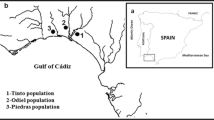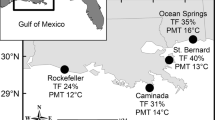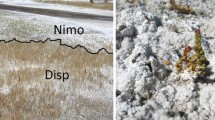Abstract
The dominant plant in Humboldt Bay salt marshes in Spartina densiflora, a species of cordgrass apparently introduced from South America. At several salt marshes and restoration sites around Humboldt Bay, distribution of this plant has increased significantly. We investigated the relative contributions of vegetative tiller production and seed germination to the establishment and expansion of S. densiflora. Lateral spread of plants surrounded by competitors were compared to areas without competing plant species. Plants growing in areas without competitors had significantly higher rates of vegetative expansion (p<0.0001). Viable seed production, germination rates, seedling survivorship, and growth of adult plants were measured in six salinity treatments. Approximately 1,977±80 viable seeds are produced per plant (0.25–0.5 m2). The number of germinating seeds was inversely related to increases in salinity. Salinity treatments between 19‰ and 35‰ produced significantly lower germination rates than salinities of 0–18‰ (p<0.0001). Seedling survivorship was 50% at ≤4‰ and 8–14% at ≥11‰. Lateral expansion of adult, greenhouse-grown plants occurred in all salinity treatments, with modest decreases in the highest salinity treatments (p<0.05). Our findings indicate that S. densiflora expands primarily by vegetative expansion, and lateral tillers are produced by throughout the year. Spartina densiflora produces prolific amounts of seed, but recruitment in mature salt marshes may be limited by competitors and higher salinities. At restoration sites, planting of native species such as Salicornia virginica, Distichlis spicata, or Jaumea carnosa may prevent monospecific stands of S. densiflora from developing.
Similar content being viewed by others
Literature Cited
Barnhart, R. A., M. J. Boyd, and J. E. Pequegnat. 1992. The ecology of Humboldt Bay, California: An estuarine profile. United States Fish and Wildlife Service, Biological Report 1.
Callaway, J. C. 1991. The introduction of Spartina alterniflora in South San Francisco Bay. Master of Arts thesis, San Francisco State University, San Francisco, California.
Callaway, J. C. and M. N. Josselyn. 1992. The introduction and spread of smooth cordgrass (Spartina alterniflora) in South San Francisco Bay. Estuaries 15:218–226.
Chapman, V. J. 1974. Salt Marshes and Salt Deserts of the World (second supplemented reprint edition). V. V. J. Cramer, Lehre, Germany.
Claycomb, D. W. 1983. Vegetational changes in a tidal marsh restoration project at Humboldt Bay, California. Master of Arts thesis, Humboldt State University, Arcata, California.
Crispin, C. D. 1976. The effects of storage, temperature and salinity on the germination response of Spartina foliosa from San Francisco Bay. Master of Arts thesis, San Francisco State University, San Francisco, California.
Dafni, A. 1992. Pollination Ecology, A Practical Approach. Oxford University Press, Oxford, England.
Eicher, A. L. 1987. Salt marsh vascular plant distribution in relation to tidal elevation, Humboldt Bay, California. Master of Arts thesis, Humboldt State University, Arcata, California.
Frenkel, R. E. and T. R. Boss. 1988. Introduction and spread of Spartina patens on Cox Island, Suislaw Estuary, Oregon. Wetlands 8:33–49.
Goss-Custard, J. D. and M. E. Moser. 1988. Rates of change in the numbers of Dunlin calidris var. alpina wintering in British estuaries in relation to spread of Spartina anglica. Journal of Applied Ecology 25:95–109.
Gray, A. J., P. E. M. Benham, and A. F. Raybould. 1990. Spartina anglica—The evolutionary and ecological background, p. 5–10. In A. J. Gray and P. E. M. Benham (eds.), Spartina anglica—A Research Review, HMSO, London, England.
Heinz, J. L. 1992. NCSS, Number Cruncher Statistical System. Product 5.3, Kaysville, Utah.
Josselyn, M. N. and J. W. Buchholz. 1984. Marsh restoration in San Francisco Bay: A guide to design and planning. Technical Report No. 3. Tiburon Center for Environmental Studies, San Francisco State University, San Francisco, California.
Lee, W. G. and T. R. Partridge. 1983. Rates of spread of Spartina anglica and sediment accretion in the New River Estuary, Invercargill, New Zealand. New Zealand Journal of Botany 21: 231–236.
MacDonald, K. B. 1977. Coastal salt marsh, p. 263–294. In M. G. Barbour and J. Major (eds.), Terrestrial Vegetation of California. John Wiley and Sons, New York.
MacDonald, K. B. and M. G. Barbour. 1974. Beach and salt marsh vegetation of the North American Pacific coast, p. 175–234. In R. J. Reimold and W. H. Queen (eds.), Ecology of the Halophytes. Academic Press, New York.
Mobberley, D. G. 1956. Taxonomy and distribution of the genus Spartina. Jowa State College Journal of Science 30:471–574.
Mooring, M. T., A. W. Cooper, and E. D. Seneca. 1971. Seed germination response and evidence of height ecophenes in Spartina alterniflora from North Carolina. American Journal of Botany 58:48–55.
Phleger, C. F. 1971. Effect of salinity on growth of a salt marsh grass. Ecology 52:908–911.
Purer, E. A. 1942. Plant ecology of the coastal salt marshlands of San Diego County, California. Ecological Monographs 12:81–111.
Rogers, J. D. 1981. Net primary productivity of Spartina foliosa, Salicornia virginica and Distichlis spicata in salt marshes at Humboldt Bay, California. Master of Arts thesis, Humboldt State University, Arcata, California.
Ryan, B. F., B. L. Joiner, and T. A. Ryan. 1984. Minitab Handbook, 2nd edition. P.W.S. Publishers, Boston, Massachusetts.
Saint-Yves, A. 1932. Monographia Spartinarem. Candollea 5:19–100.
SAS Institute, Inc. 1985. SAS User’s Guide: Basics, Version 5 Edition. Cary, North Carolina.
Scholten, M. and J. Rozema. 1990. The competitive ability of Spartina anglica on Dutch salt marshes, p. 39–47. In: A. J. Gray and P. Benham (eds.), Spartina—A Research Review. NERC Institute for Terrestrial Ecology, London, England.
Seneca, E. D. 1967. Seed germination and seedling development of four dune grasses from the outer banks of North Carolina. Doctoral thesis, North Carolina State University, Raleigh, North Carolina.
Seneca, E. D. 1974. Germination and seedling response of Atlantic and Gulf coasts populations of Spartina alterniflora. American Journal of Botany 61:947–956.
Spicher, D. P. 1984. The ecology of a caespitose cordgrass (Spartina sp.) introduced to San Francisco Bay. Master of Arts Thesis, San Francisco State University, San Francisco, California.
Spicher, D. P. and M. D. Josselyn. 1985. Spartina (Gramineae) in northern California: Distribution and taxonomic notes. Madroño 32:158–167.
Thompson, J. D. 1991. The biology of an invasive plant. Spartina anglica. Bioscience 41:393–401.
Ungar, I.A. 1978. Halophyte seed germination Botanical Review 44:233–264.
United States Army Corps of Engineers. 1976. Disposal Study, San Francisco Bay and Estuary, Appendix A. Marshland Development, United States Army Engineer District, San Francisco, California.
Woodhouse, W. W. and P. L. Knutson. 1982. Atlantic coastal marshes, p. 45–70. In R. R. Lewis (ed.), Creation and Restoration of Coastal Plant Communities. CRC Press, Boca Raton, Florida.
Woodhouse, W. W., E. D. Seneca, and S. W. Broome. 1972. Marsh building with dredge spoil in North Carolina. Agricultural Experimental Station, North Carolina State University, Raleigh, North Carolina.
Woodhouse, W. W., E. D. Seneca, and S. W. Broome. 1976. Propagation and use of Spartina alterniflora for shoreline erosion abatement. United States Army Corps of Engineers. Coastal Engineering Research Center, Fort Belvoir, Virginia.
Author information
Authors and Affiliations
Corresponding author
Rights and permissions
About this article
Cite this article
Kittelson, P.M., Boyd, M.J. Mechanisms of expansion for an introduced species of cordgrass, Spartina densiflora, in Humboldt Bay, California. Estuaries 20, 770–778 (1997). https://doi.org/10.2307/1352250
Received:
Accepted:
Issue Date:
DOI: https://doi.org/10.2307/1352250




